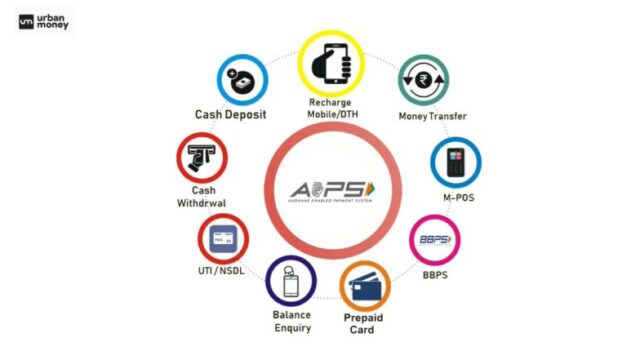- Home
- Adhaar Card
- Aeps Aadhaar Enabled Payment System
AEPS: A Guide to Aadhaar Enabled Payments System

- Personalized solutions
- Expert guidance
- Application assistance
- Credit score discussion
- Interest rate comparison


Last Updated: 27 December 2025
The Aadhaar Enabled Payment System (AEPS) is a unique identification number-based payment system that allows you to make seamless financial transactions. In addition to issuing the Aadhaar card, UIDAI also handles other services related to it, such as generating, updating, and locking the card. This article explains AEPS benefits, features, mechanisms, background, and uses.
What AEPS – Aadhaar Enabled Payment System?
The AEPS aims to empower digitisation in India and to make society aware of banking and financial services with the help of Aadhaar cards. AEPS helps individuals transfer funds and make financial transactions, such as deposits, withdrawals, etc. Aadhaar enabled payment system provides a simple and user-friendly platform for making financial transactions. To avail of this service, an individual must provide Aadhaar Verification at a Point of Sale (POS) or micro ATM.

The National Payment Corporation of India (NCPI) took this initiative to encourage cashless modes of financial transactions in India. Aadhaar cardholders can carry out all their financial transactions through a micro ATM or a business correspondent (BC). For all the financial transactions, you can use business Correspondent (BC) except for those fund transfers where you need to visit the specific banks.
Note: To avail of this service, you need to link your bank account with your Aadhaar card, which has been made mandatory.
How to Use Aadhaar Enabled Payment System?
Using the Aadhaar enabled payment system is simple. Check out the below-mentioned steps to use AEPS:
Step 1: Visit the micro ATM of the banking correspondent.
Step 2: Present the 12-digit unique identification code and the bank’s name.
Step 3: Choose the transaction type according to your preference.
Step 4: You must authenticate and verify via biometric information such as fingerprints or iris scans.
Step 5: Once the verification is done, you must collect the receipt.
What are the Different Services Offered by Aadhaar AEPS?
The Aadhaar enabled payment system provides numerous services. Check out the below-mentioned services offered by AEPS:
- C2B and C2G payment transactions
- To enquire about the balance amount
- To make a cash withdrawal
- Individuals can also make Aadhaar to Aadhaar fund transfers
- Mini statement
- Authentication
- BHIM Aadhaar pay
Other services provided by AEPS are Aadhaar seeding status, tokenisation, demo auth, eKyc, and so on.
Benefits and Features of Aadhaar Enabled Payment System
- AEPS empower bank customers to use Aadhaar as the tool of identity for Aadhaar enabled bank account and perform basic banking transactions: The basis banking transactions include cash deposit, cash withdrawals, intrabank or interbank fund transfer, mini statement, and balance enquire through a Business Correspondent.
- AEPS facilitates inter-operability across banks safely and securely.
- APES facilitates disbursement of government entitlements such as Social Security Pension (SSP), NREGA, Handicapped Old Age Pension etc., of any state or central government body using Aadhaar and authentication via the Unique Identification Authority of India.
- It also serves the purpose of electrification or retail payments
- APES enables banks to route Aadhaar initiated interbank transactions through a central switching and clearing agency.
- AEPS only requires biometric identification and a 12-digit unique identification code to initiate a transaction.
Mechanism of Aadhaar AEPS
The Aadhaar Enabled Payment System works similar to a Point of Sale (POS) machine. Instead of a credit/debit card pin, the merchant keys the customer’s Unique Indemnification Number and, for authentication, the customer’s biometric data is required.
Below-mentioned information is required to carry out an AEPS transaction:
- Name or Bank’s Issuer Identification Number (IIN)
- 12-digit unique identification number (Aadhaar Number)
- Fingerprint
Background of Aadhaar Enabled Payment System
The Aadhaar Enabled Payment System is a bank-led model allowing online financial transactions at Point of Sale (POS) through the Business Correspondent of banks via Aadhaar authentication. Furthermore, AEPS allows the performance of six types of transactions.
Things to Remember While Using Aadhaar Enabled Payment System
There are a few things that an individual needs to keep in mind while carrying out an AEPS transaction. Check out the below-mentioned key pieces of information below to get a better understanding of AEPS transactions.
It is mandatory to link your Aadhaar card with your bank account.
If you have multiple bank accounts, you need to select one of them, which will be used under AEPS.
To carry out an AEPS transaction, no OTP or security code is required.
Individuals can only make transactions between their Aadhaar linked bank accounts.
Accounts from different banks can be used for AEPS transactions. However, individuals are allowed to select one account to avail of this banking facility.
Fund Transfer Limit of Aadhaar Enabled Payment System
According to the Reserve Bank of India (RBI), INR 10,000 per withdrawal is the limit for transactions made through AEPS. However, several banks have capped the AEPS transaction to prevent it from being misused. In such banks, the daily limit of the maximum amount transferable is INR 50,000.
Reason Behind Launching Aadhaar Enabled Payment System
The answer to that question is the banking framework and digitisation. The government took this initiative to bring the masses into the Indian digitisation movement and help everyone make cashless payments. Cashless payment leaves a digital footprint that helps in tracking the transactions. It also prevents tax evasion and brings the fund transfer onto the government’s record. In remote areas, it is not feasible to open bank branches. Thus, to overcome this, the government has introduced AEPS, where individuals can get access to the Indian banking system and will be able to make financial transactions electronically with the help of banking correspondents and micro ATMs.
AEPS requires biometric authentication such as fingerprint/iris scan, which makes it more secure than regular paper transactions as the signature can be forged, but biometric information can’t. This paperless transaction doesn’t require an individual to carry a passbook or credit/debit card. All you need is your 12-digit unique identification number and your fingerprint.
To Sum Up
The Aadhaar Enabled Payment System is the bank-led model, allowing online financial transactions at Point of Sale (POS) through the Business Correspondent of banks via Aadhaar authentication. The Unique Identification Authority of India looks after the mechanism of AEPS. The Aadhaar Enabled Payment System is a paperless banking facility that is more secure as it requires biometric authentication for transactions. The government took this initiative to tackle tax evasion and enhance India’s banking framework and digitisation. Al Aadhaar cardholders can avail themselves of this AEPS facility of the Unique Identification Authority of India.
FAQ's About Aadhaar Enabled Payment System (AEPS)
How do I activate my AEPS service?
In order to activate your AEPS service, you need to link your Aadhaar card with your bank account. Once you link it you need to visit your bank and ask the executive to activate this service.
How much money withdraw from AEPS?
According to the Unique Identification Authority of India, cash withdrawal from micro ATMs of AEPS is limited to INR 10,000 per transaction.
When was AEPS launched in India?
This bank-led model was launched in November 2010 in India. It has become popular that last year (2021) a total of 9.6 crore transactions worth INR 25,860.92 crore took place through AEPS.
Who can use AEPS?
Individuals who have enrolled themselves in UIDAI and have a valid Aadhaar card can use Aadhaar Enabled Payment System.
What is an IIN
IIN Issuer Identification Number, which is a 6-digit number which helps in the identification procedure of the bank.
